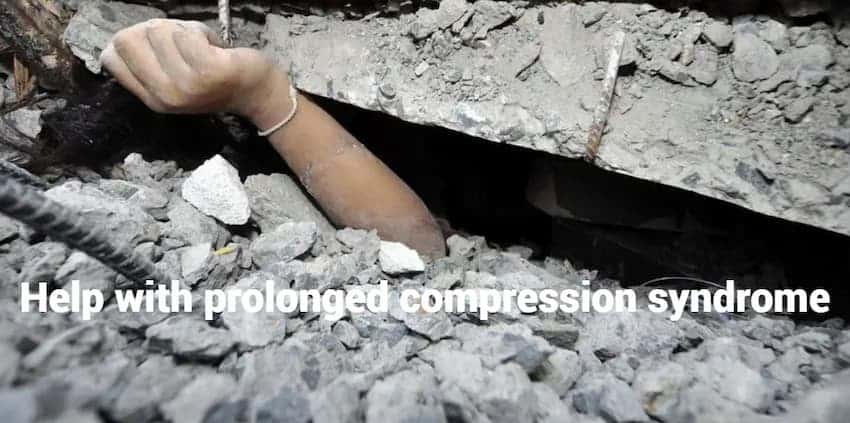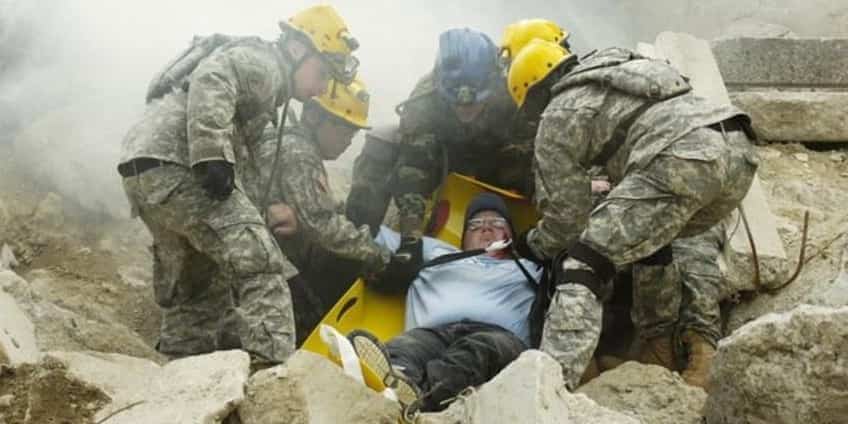Help with prolonged compression syndrome
Content
- What is crash syndrome?
- Stages of crash syndrome development
- Causes of crash syndrome
- Signs of crash syndrome
- Clinical periods of crash syndrome
- Compression period
- Early post-compression period
- Interim period
- Late period
- First aid for crash syndrome
- What not to do in case of crash syndrome

Prolonged compression syndrome is a serious condition that requires immediate medical attention. In extreme situations, such as accidents, collapses or disasters, it is important to provide victims with the correct first aid before doctors arrive. Actions taken at the scene can have a significant impact on a person's further condition and chances of recovery.
In this article, we will look at the basic principles of first aid, possible complications and important aspects of caring for victims. Understanding the correct algorithm of actions will help reduce health risks and save lives.
What is crash syndrome?

Crush syndrome, or prolonged compression syndrome, is a critical condition that occurs as a result of prolonged external pressure on a certain part of the body. This disrupts the blood supply to the affected area, leading to serious damage to muscles, nerves and soft tissues.
The main mechanism of development of this condition is associated with a disorder of tissue nutrition and elimination of toxic substances from the body. As a result, after being released from compression, harmful decay products enter the bloodstream, which can lead to serious complications, including intoxication, kidney failure and even death.
Crush syndrome most often develops when soft tissues are compressed for a long time (4-8 hours or more) as a result of accidents, collapses or disasters, so it is especially important to know the rules of first aid in such cases.
Stages of crash syndrome development
Crash syndrome has two main stages, each of which poses a serious danger to the victim. Impaired blood circulation during compression leads to tissue death, and after the person is released from the pressure, toxic processes are triggered in the body, which can lead to severe complications.
- The compression stage. As a result of prolonged pressure on a certain part of the body, the blood supply is cut off, the tissues do not receive oxygen, and toxic waste products accumulate in the muscles. This lasts from 1 to 2 hours or longer, depending on the strength of the compression.
- The release stage. After the pressure is released, the toxins accumulated in the compressed tissues are abruptly released into the bloodstream. This can lead to acute intoxication, kidney dysfunction (a sign is dark brown urine or its absence), heart rhythm disorders and shock.
It is the second stage that is the most dangerous, as the body does not have time to adapt to the dramatic changes in tissue and blood circulation. Accumulated toxins and decay products can cause severe disruption of the functioning of vital organs, including the heart, liver, kidneys and brain. Particularly dangerous is an increase in the level of potassium in the blood, which can cause fatal heart rhythm disorders.
Since the symptoms of intoxication do not always appear immediately, the victim's condition may appear stable, which creates a false sense of security. However, a few hours or even minutes after being released, the victim's general health deteriorates sharply, with weakness, nausea, impaired consciousness and convulsions. Without timely medical care, acute renal failure can develop, requiring immediate treatment, including haemodialysis.
Due to the high mortality rate from crash-related complications, it is particularly important to provide first aid before the victim is released. In such cases, competent and cautious actions are required to minimise risks and reduce the likelihood of critical consequences.
Causes of crash syndrome

Crush syndrome develops as a result of prolonged compression of body parts, especially the extremities, which leads to impaired blood circulation and tissue death. The most common situations that cause this condition are accidents, natural disasters, military operations and accidents involving physical injuries.
- Car accidents when the victim is trapped between metal structures or under the weight of a vehicle.
- Building collapses during earthquakes, collapses or explosions, when debris traps limbs or other parts of the body.
- Combat operations, when explosions or the destruction of buildings lead to prolonged compression of tissues.
- Prolonged immobility in an unconscious state, for example, due to severe alcohol or drug poisoning, when the weight of one's own body causes positional compression of the limb.
- Incorrect tourniquet application or too tight a bandage, which restricts venous outflow but partially preserves arterial blood flow, which contributes to the rapid accumulation of toxins in the tissues.
The mechanism of crush syndrome development is associated with the cessation of blood circulation and lymph flow in the compressed area, which leads to oxygen starvation of the tissues. As a result, toxic metabolic products accumulate, causing acidosis, red blood cell destruction and plasma loss to the adjacent tissues. After the affected limb is freed, a sharp vasodilation and toxins entering the bloodstream causes hypovolaemia, intoxication and dysfunction of vital organs.
A critical consequence of crash syndrome is the release of large amounts of harmful substances into the bloodstream, including potassium, myoglobin, histamine and toxic metabolites. This can cause serious complications: acute renal failure, toxic heart damage, blood clotting disorders, infectious complications and general intoxication. In severe cases, toxic-bacterial shock and death may occur.
Signs of crash syndrome
Crush syndrome is manifested by a number of symptoms that can vary depending on the duration of the compression and the extent of tissue damage. One of the first and most pronounced manifestations is severe pain in the affected area, which often does not correspond to the actual extent of the injury. Even after the compression is released, the pain may remain intense or, on the contrary, be reduced due to the destruction of nerve endings.
Another characteristic symptom is impaired skin sensitivity, which manifests itself in the form of paresthesia - a tingling, burning or itching sensation. This is due to insufficient blood supply to the nerve tissues in the affected area.
In the later stages of crash syndrome, there may be a complete loss of sensation and mobility of the limb, which indicates the development of paralysis. The absence of a pulse in the peripheral arteries is another warning sign that indicates a critical circulatory disorder. The affected area becomes pale in colour, indicating a lack of oxygen supply and possible tissue necrosis.
The signs of crash syndrome can develop gradually, so it is important to closely monitor the victim's condition even after his or her release. Early diagnosis and proper first aid can help reduce the risk of severe complications and save a person's life.
Clinical periods of crash syndrome
Crash syndrome develops in stages, and each clinical period is characterised by specific changes in the body. From the moment of tissue compression to recovery or the development of complications, several stages take place, during which blood circulation disorders, intoxication and gradual damage to vital organs occur.
The dynamics of the syndrome depends on the duration of the compression, the volume of the affected tissue and the general condition of the body. The longer the victim was exposed to external pressure, the more severe the consequences can develop after his or her release. Understanding these periods allows us to correctly assess the victim's condition and provide the necessary assistance in a timely manner.
Compression period
During the compression period, the victim usually remains conscious, but his or her psycho-emotional state may change. Apathy, lethargy, drowsiness, and in some cases, periods of agitation and anxiety are common. A person may feel fearful, depressed, or, on the contrary, aggressive and anxious.
One of the main symptoms is severe pain in the area of compression, which may be accompanied by numbness or tingling sensations. The victim also complains of intense thirst, dry mouth and a feeling of shortness of breath. All of this is a result of poor circulation, hypoxia and the accumulation of toxic substances in the tissues.
The duration of this period depends on the strength and duration of the compression. The longer it lasts, the more severe the consequences after release, so even if there are no visible serious injuries, the victim should be given immediate first aid.
Early post-compression period
After the affected limb or other part of the body is freed, the victim quickly develops generalised weakness, dizziness, nausea and a pronounced feeling of thirst. Pain in the affected area may increase due to restoration of blood flow and irritation of nerve endings. At the site of prolonged compression, various changes in the soft tissues are observed, including edema accompanied by plasma loss, impaired microcirculation and lower blood pressure.
One of the dangerous signs of this period is the development of traumatic neuritis and plexitis, which leads to impaired sensation and motor function of the affected limb. At the same time, tachycardia, hypercoagulation and signs of thrombohemorrhagic syndrome appear, which increases the risk of thrombosis and blood clotting disorders. Due to massive necrosis of muscle fibres and the ingress of toxic substances into the bloodstream, endogenous intoxication increases, which can lead to respiratory failure and the development of respiratory distress syndrome.
An important laboratory indicator is changes in the composition of blood and urine. The levels of potassium, phosphorus, myoglobin, urea, and creatinine increase in the blood. At the same time, the amount of urine decreases, which at first has a reddish tint due to the presence of haemoglobin and myoglobin, and later becomes dark brown. It contains a large amount of protein, leukocytes, erythrocytes, as well as crystals of hematin and amorphous myoglobin.
This period is characterised by the development of shock, acute renal failure and multiple organ dysfunction. The sooner qualified medical care is provided, the higher the chances of avoiding serious complications.
Interim period
At this stage, the victim's condition is significantly complicated due to the development of multiple organ failure. The most pronounced manifestation is the deterioration of kidney function, which causes retention of toxic substances in the body and further increase in intoxication. At the same time, purulent and necrotic processes in the damaged soft tissues progress, which increases the risk of septic complications.
Against the background of general exhaustion of the body, anaemia often develops, which leads to a decrease in the level of oxygen in the blood and a deterioration in the condition of internal organs. Complications of the respiratory system, including secondary pneumonia, pleurisy and atelectasis, can lead to impaired gas exchange and respiratory failure.
The cardiovascular system is also heavily stressed. Myocardial dystrophy occurs, which impairs the contractility of the heart muscle, and in some cases, inflammatory myocarditis develops. The liver suffers from toxic effects, which manifests itself in the form of toxic hepatitis.
The effect of toxic substances on the gastrointestinal tract can cause intoxicating intestinal paresis, which impedes intestinal motility and can lead to stagnation of the contents. Blood clotting disorders contribute to the development of thrombo-haemorrhagic syndrome, which increases the risk of both bleeding and blood clots.
This period is critical, as a combination of complications can lead to irreversible consequences. Timely intensive care is aimed at maintaining the functions of vital organs and combating intoxication.
Late period
At this stage, the general condition of the victim gradually stabilises, and the main manifestations of intoxication decrease. Kidney function begins to recover, which helps to normalise water and electrolyte balance and improve metabolism. The swelling of the affected limb disappears, and the general symptoms gradually give way to localised lesions.
However, complications associated with long-term circulatory disorders and tissue damage occur in the compression zone. Muscle atrophy becomes noticeable, which significantly reduces the functionality of the limb. Contractures develop that limit joint mobility and can lead to permanent deformity. Ischaemic neuritis causes severe pain, sensory disturbances and weakness of the affected area.
The later period requires long-term rehabilitation aimed at restoring mobility, strengthening muscles and reducing pain. Timely treatment helps to minimise the consequences and improve the quality of life of the victim.
First aid for crash syndrome

First aid in a crash is critical, as the right actions can save the victim's life and reduce the risk of serious complications. The first step is to make sure that the scene is safe, then calm the victim down and explain what to do next.
If less than 10 minutes have passed since the moment of compression, carefully release the affected part of the body. In the event of heavy bleeding, stop it immediately by applying direct pressure, tourniquet or tamponade. In the event of a fracture, the injured limb should be fixed with a splint. If the victim shows signs of shock, follow standard protocols for shock care.
If more than 10 minutes have passed since the moment of compression, it is not recommended to release the affected part of the body without medical supervision, as this can cause a sudden release of toxic substances into the bloodstream and lead to a critical deterioration in the condition. In such a case, a tourniquet should be applied above the injured area to slow the release of toxins into the bloodstream before removing the compression.
The main first aid measures for crash syndrome include:
- Pain relief. The administration of analgesics or a novocaine block helps to reduce pain and prevent pain shock.
- Infusion therapy. Intravenous administration of saline solutions helps to maintain the volume of circulating blood and reduce intoxication.
- Prevention of infections. If there is a risk of infection, tetanus serum should be administered.
- Keeping warm. The victim should be covered with a thermal blanket or a blanket to avoid hypothermia.
- Monitoring of the condition. It is necessary to ensure constant supervision until the arrival of medical assistance and, in case of deterioration, immediately call an ambulance again.
If possible, collect as much information as possible about the circumstances of the injury and pass it on to medical professionals. If the victim loses consciousness before the ambulance arrives, you should act in accordance with the protocols for first aid in case of sudden cardiac arrest. Correct and timely action at the first aid stage significantly increases the chances of survival and reduces the risk of serious complications.
What not to do in case of crash syndrome
It is important to act with caution when assisting a victim with crash syndrome, as improper actions can significantly worsen their condition and cause serious complications.
Do not pull the victim sharply or roughly, especially if the limb or other part of the body remains trapped. Sudden release of tissue without proper preparation can cause a sudden release of toxic substances into the bloodstream, leading to acute intoxication and a sharp deterioration in health.
Do not neglect to apply a tourniquet before releasing the affected limb or immediately after releasing it if the compression lasted more than 10 minutes. This is necessary to control blood circulation and prevent the development of toxic shock.
It is strictly forbidden to self-medicate or delay calling an ambulance. The victim needs qualified medical care, so you should call an ambulance immediately. If transportation to the hospital is possible on your own, you should do so only after agreeing with the ambulance dispatcher and taking all necessary safety precautions.


